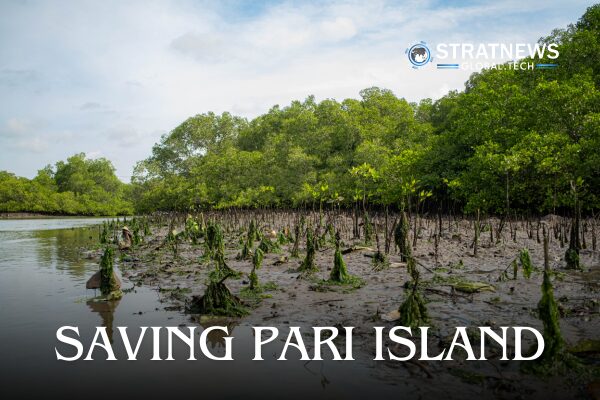Indonesian Women Lead Mangrove Revival as Climate Threats Swallow Pari Island
Under the blazing tropical sun, Asmania and a small group of women from Indonesia’s Pari Island wade into the shallow waters of Rengge Beach, planting young mangrove seedlings. Their mission is simple but urgent — to save their sinking island from the rising sea.
Fighting Floods with Mangroves
The Women’s Group of Pari Island hopes the mangroves will help protect their home from tidal floods, erosion and increasingly powerful waves. The trees also store carbon, helping to reduce the greenhouse gases driving climate change.
“The sea is not like it used to be. It’s hotter, rougher, and it scares us,” said Asmania, a mother of three, her hands buried in wet sand as she worked.
Home to around 1,000 residents, Pari Island has become a global symbol of climate justice. In 2023, Asmania and three other islanders filed a lawsuit against Swiss cement giant Holcim, accusing it of contributing to rising sea levels through its emissions. The case, now before a court in Zug, Switzerland, has not yet been accepted for full hearing.
A Sinking Paradise
Indonesia, with over 81,000 kilometres of coastline, faces some of the world’s fastest rates of sea-level rise — about 4.25 millimetres a year since 1992. Environmental groups warn that 11% of Pari’s land has already vanished beneath the waves, and the island could disappear entirely by 2050.
Although Holcim no longer operates in Indonesia, Asmania believes its global emissions play a role in her island’s fate. “This is global damage,” she said. “It’s unfair because we are the ones suffering.”
The island’s once-thriving seaweed and fish farms are struggling as warmer waters take their toll. “Our seaweed harvest failed last year. It all melted from the heat,” said Asmania. Her husband, Sartono, said only seven of the 400 groupers he raised survived two months.
A 2025 Frontiers in Marine Science study found that sea surface temperatures in Indonesia have risen by 0.19°C per decade since 1982, harming marine life and fisheries.
The Push for Corporate Accountability
Holcim maintains that climate regulation is the responsibility of governments, not courts, but says it is investing in decarbonisation technologies. Still, legal experts note a growing trend of communities challenging large emitters across borders.
“There is global momentum for holding corporations accountable for the climate crisis,” said Jakarta-based lawyer Glenn Wijaya. “People are testing new legal pathways for justice.”
Other landmark cases include a Peruvian farmer’s lawsuit against German energy firm RWE, which — although unsuccessful — set a precedent for linking emissions to local harm.
Mangroves: Nature’s Coastal Shield
For Asmania and fellow islanders like Mustaghfirin, the solution lies in nature itself. Mangroves offer vital coastal protection, stabilising shorelines, trapping sediment and absorbing up to 90% of wave energy. They also provide breeding grounds for fish, crabs and sea cucumbers, supporting local livelihoods.
“Fishermen rely on nature,” Mustaghfirin said. “If we treat it well, it will protect us.”
Indonesia hosts 20% of the world’s mangroves — a crucial asset both for biodiversity and carbon capture. According to the World Bank, each hectare of mangroves can generate up to $50,000 a year in combined benefits from tourism, fishing and carbon sequestration.
Yet growing them is not easy. “Only about half of planted mangroves survive,” said Greenpeace campaigner Jeanny Sirait. Seedlings need enough sunlight and must withstand strong waves and tides.
Despite the odds, Asmania remains determined. “Planting mangroves is our way of holding on,” she said, gazing toward the encroaching sea.
with inputs from Reuters


